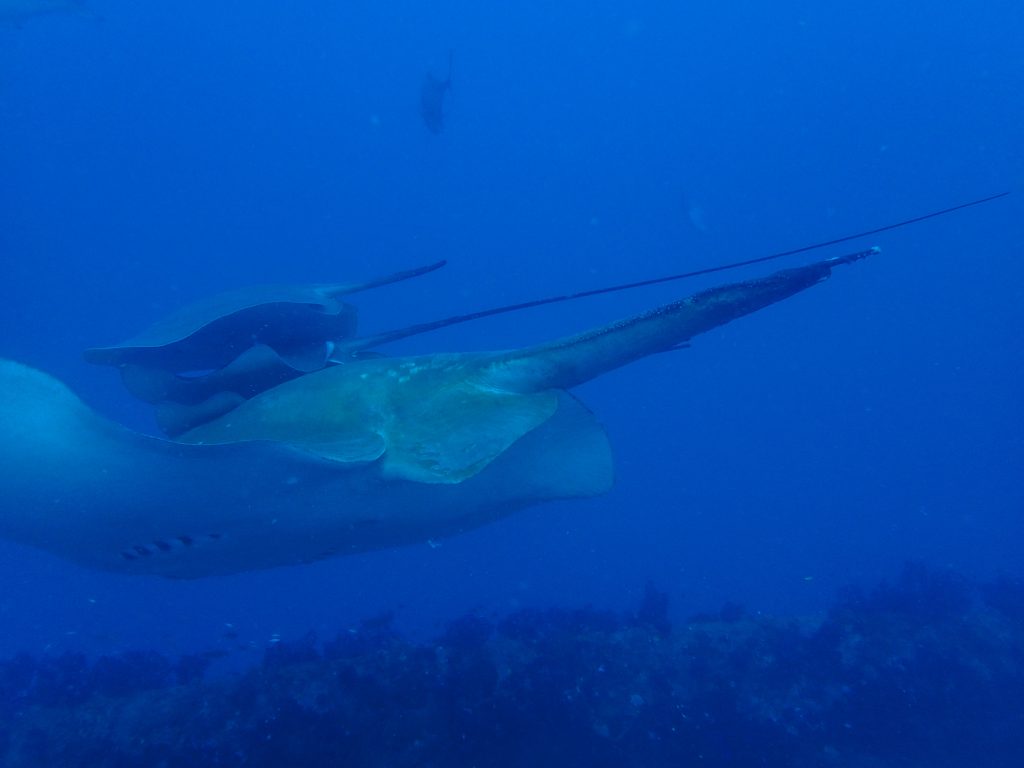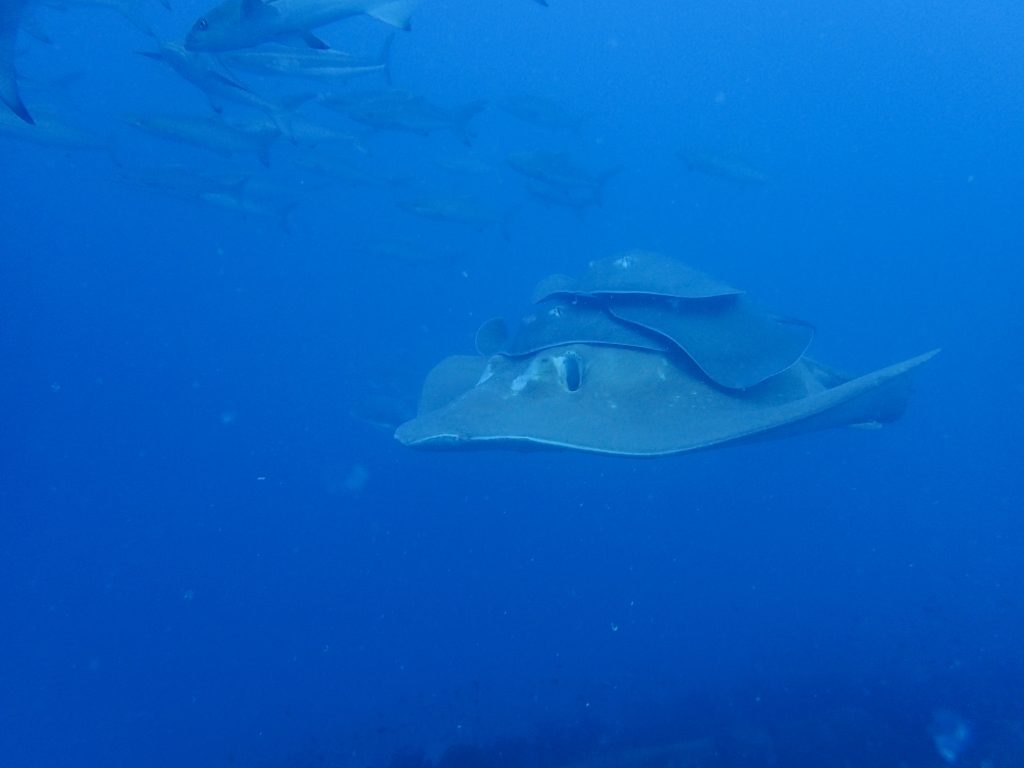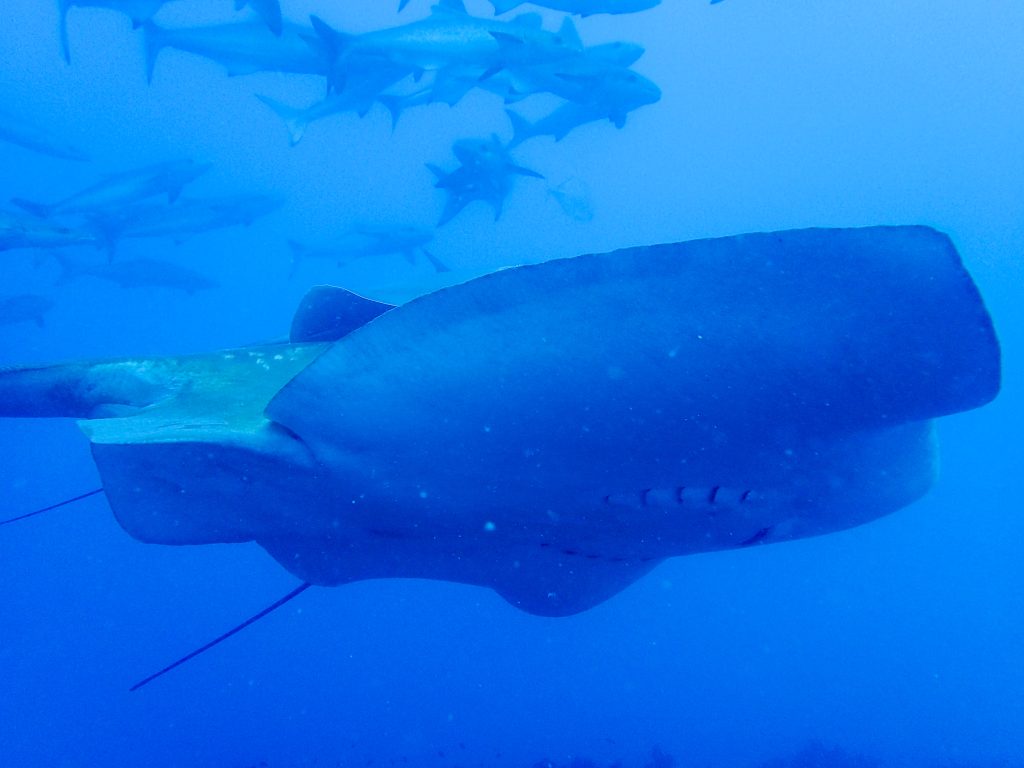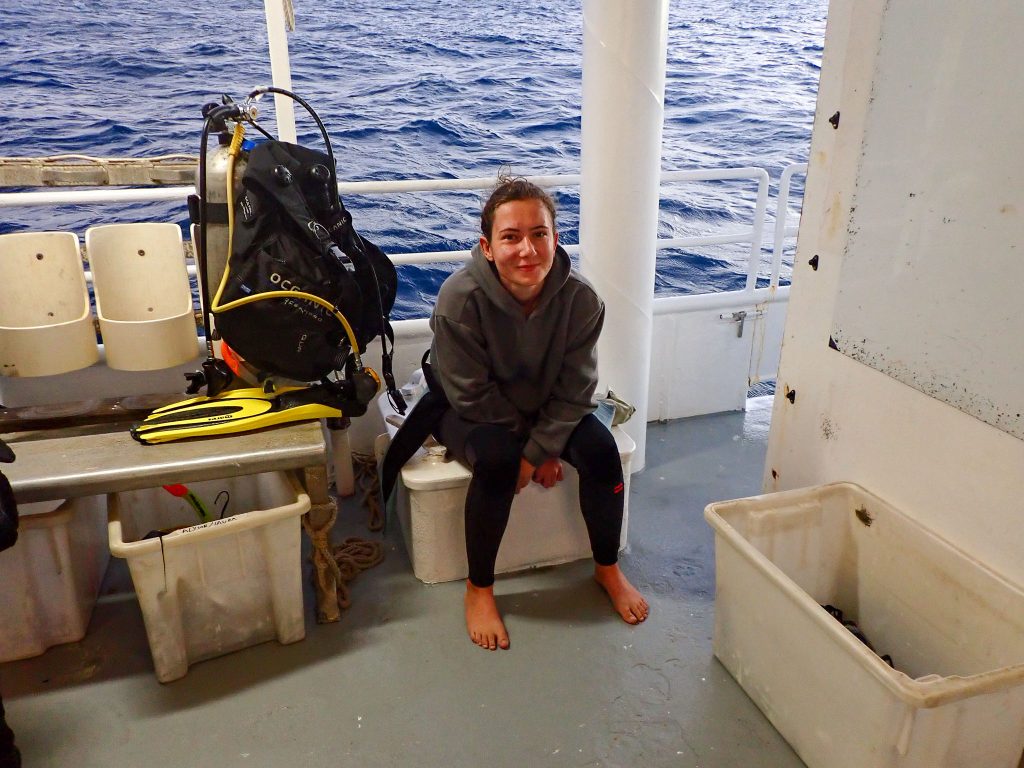There was just one eyewitness to Steve Irwin’s death. He said that the massive ray stung Irwin wildly across his chest with its tail, and that the barb pierced his heart, and he bled out.
I swam with a massive ray last Monday morning at the Yongala wreck – on sunrise.
At any moment that stingray could have attacked us with its stout tail holding sharp barbs. That tail was variously swung over my head as the ray circled, seemingly curious, each time wanting to get a bit closer, to see me better.

I always look for an animal’s eyes, to get a sense of the situation. But this ray, it has tiny eyes, about the size of sultanas! I could only sense that it was curious, and that it meant us no harm.
Perched above it were three much smaller coachwhip rays, and they were having trouble keeping their balance as this smalleyed ray, this rare and elusive Megatrygon microps swam away, only to circle back. It was fun just watching the coachwhips slip and slide.


A stingray’s venom is not necessarily fatal, but it is apparently excruciatingly painful. The venom is composed of the enzymes 5-nucleotidase and phosphodiesterase and a neurotransmitter that causes muscles to contract. The most destructive part of the sting mechanism, more dangerous than the venom, are the barbs on the spine. The sharp tip of the sting will enter a person smoothly, but its exit is roughly equivalent to backing up over blades. Pulling the spike out of a human’s chest or abdomen can apparently be enough to cause death from the massive tearing of tissue that results.
Megatrygon microps is the largest species of stingray in the world with a width of 2 metres and some. But I felt calm in its presence, and I also wanted to get closer.
The four of us, Thomas, Jessica and Alyson, had jumped in some 15 minutes earlier off the MV SeaEsta for a second dive that morning, on Monday 6th May. It can be difficult – diving the Yongala. There was a 2-metre swell forecast, but we jump into something less than that. ‘A bit rollie,’ was how first mate Kerrie described it.
My objective was to just get in and get down the 18 metres to the wreck and hopefully make it the entire length – to swim the entire top of the wreck, the entire length of the Yongala without running out of air. If I got to the other end with 120 bars, I would be happy.
We got there, to the stern and did an air check. My three buddies and I, we each still had at least 120 bars. Whoo hoo! And the current would take us back to the bow, from where we would make our ascent.
I was feeling happy. Relaxed. I could see a giant groper in the distance, purple soft corals and golden fish covered the top of the wreck.
Then it appeared.
It hovered and then swung around. Moved away and then returned. It swung its tail over my head, and I saw the barbs up close. Jessica filmed much of the encouter, with her GoPro.
We hovered, it circled, Thomas moved a bit closer, Jess kept filming.
It was a magical encounter!
The Yongala wreck is inside the Great Barrier Reef Marine Park, approximately 48 nautical miles south-east of Townsville not far from the mouth of the Burdekin River draining a catchment rich with sugarcane and beef cattle.
I am so grateful to Paul Crocombe and Adrenalin Dive for the opportunity, for this memory of swimming with a rare and elusive Megatrygon microps — a giant smalleyed ray, with three coachwhips atop slipping and sliding.

Notes, from National Geographic
“The smalleye stingray is a study in contrasts and surprise. It has a wingspan that stretches greater than seven feet, yet its eyes are the size of raisins. While most stingrays avoid humans, the smalleye appears to be inquisitive, sometimes swimming within feet of scuba divers. And despite being the world’s largest oceanic stingray, it is very rarely spotted alive, and almost nothing is known about it.
Before the early 2000s, there were only a couple verified live sightings of smalleye stingrays (Megatrygon microps). But in the past 15 years, biologist Andrea Marshalland colleagues have spotted 70 individuals off the coast of Mozambique, and they’ve catalogued some of these observations in the world’s first study on the animals, published this month in the journal PeerJ.
The paper shows that these rays can be identified individually by the unique spot pattern that each has on its back, which will allow researchers to use photos and videos taken by citizen scientists around the world to track where specific animals … click here for more information.

Jumping in on the first dive, as filmed by Jessica — Thomas, then Alyson and then Jen/me.
‘A ship in harbour is safe. But that is not what ships are built for.’
The MV SeaEsta at the Townsville Breakwater marina last Friday evening, as we boarded for the new adventure. I had no idea at that time of the friends I would make, the smalleyed ray/Megatrygon microps that would preoccupy my thoughts, dominate my memory of events afterwards.

All video by Jessica. All the photographs of the ray (and Alyson) are by me/Jen with my Olympus TG6.
Update.
And Jessica has sent me more, a clip of Thomas and I on the dive deck immediately after the first dive.



 Jennifer Marohasy BSc PhD is a critical thinker with expertise in the scientific method.
Jennifer Marohasy BSc PhD is a critical thinker with expertise in the scientific method.

Thank you Jennifer for the awesome photos and footage. The natural world is truly a wonderful thing.
Wonderful that you saw one of these big rays up close and safely, underneath it in mid water – quite a rare sight.
There is of course a major difference with your encounter and the hapless Irwin’s
I imagine at some time in your diving experience a competent dive guide would have advised you to never swim over the top of them at close range.
They will all react instantly, instinctively and violently, arching their backs and tails and their now erect barbed spines in an attempt to drive the spines into what they think is an attacking hammerhead or tiger shark.
I have seen them react in this way to a shadow looming over them in crystal clear water and a sunny midday from a diver above them – at a safe distance of course.
You would have to be very, very close to get hit by them.
I have found these spines in the throats of those two species of sharks who love rays of all species for a meal.
Indeed, they were often used as berley by some, including me, to bring tigers close for those divers who like to see them these big sharks up close.
Irwin apparently, (and I am relying on info from someone who should know), was swimming in a very shallow lagoon on Batt Reef and swam from behind and over the top of the big fella ray and may have even tried to handle it !
The ray reacted as they all would do in that situation – it didn’t attack, as much of the media reported, it just went into its instinctive, violently aggressive defensive procedure.
That Irwin did not know or ignored these basic facts, says much about Irwin.
When you consider the colossal number of individual tourist dives, that have been safely carried out on the GBR since about the 1970s, with no other “attacks” by these big peaceful creatures, you can see that Irwin was responsible for his own completely avoidable death – death by ignorance.
I should add that my remarks were mainly about another species of giant sting ray, the short-tail stingray, (Dasyatis brevicaudata) – the species that killed Irwin.
As you note, your encounter was with the semi-pelagic and much more rare, small eyed ray.
I saw one of these at the Swains years ago and another at Kenn Reef and they are not common.
But they both share the same instinctive defense reaction.
So much thanks to Jessica, for more clips, more memories, including Thomas and I discussing the first dive, on exit on the dive deck:
“My three buddies & I.” 😉
There used to be a small trawler wreak about 20k further south. We could see the mast when we were kids in the 50’s. Most likely broken up now. My father said it was there when he was a kid in the 30’s.
*****
Fixed! Cheers, Jen xo
Hi Jennifer
Thankyou. We sailed around the Whitsundays several years ago and came upon several manta rays in a bay on one of the islands. I immediately put on a wet suit and dived in with a camera belonging to a mate. The manta rays would sort of come close, but if I made a move towards them they would just swim off. I felt very privileged in their territory
Fascinating descriptions of a rare encounter Thank you
Great work Jennifer, We find your work fascinating to say the last.
Enjoy while you can.
https://www.vox.com/climate/24137250/coral-reefs-bleaching-climate-change